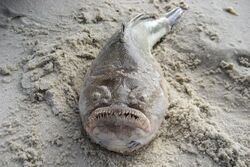Biology:Astroscopus guttatus
| Northern stargazer | |
|---|---|

| |
| Scientific classification | |
| Domain: | Eukaryota |
| Kingdom: | Animalia |
| Phylum: | Chordata |
| Class: | Actinopterygii |
| Order: | Trachiniformes |
| Family: | Uranoscopidae |
| Genus: | Astroscopus |
| Species: | A. guttatus
|
| Binomial name | |
| Astroscopus guttatus Abbott, 1860
| |
Astroscopus guttatus (northern stargazer) is a fish that can reach lengths of 22 inches (56 cm) and is found on the Atlantic shores between the states of North Carolina and New York in the United States. The northern stargazer can be found up to depths of 120 feet (37 m). Stargazers have a flat forehead with a lot of body mass up front near the mouth.
Description
The northern stargazer has a blackish brown body with white spots that are of the same size all over its head and back. It has three dark horizontal stripes on its (white) tail. The mouth of the stargazer faces up so that it can ambush prey while hiding in the sandy bottoms of coastal bodies of water. The top of the stargazer has electric organs in the orbitae[2] which can generate and transmit an electric shock. The electric apparatus is composed of two organs, which form two vertical columns roughly oval in horizontal section, and placed behind and somewhat under each eye. It is composed of about 200 thin layers of electric tissue. [3]
Ecology
Northern stargazers live primarily along the eastern seaboard of the United States. They bury themselves in the sand and wait for prey (usually smaller fish) to happen by.[4] Their eyes are situated on top of the head and poke up through the sand, hence the name stargazer.[5] The stargazer's scientific name is Astroscopus guttatus where Astroscopus means "one who aims at the stars" and guttatus translating into "speckled" – referring to the white spots on the fish's back.
Life cycle
Stargazers lay small, transparent eggs on the bottoms of bays. These eggs float to the surface after they are released. They hatch into larvae which grow up to 6–7 mm (0.24–0.28 in). They slowly grow a dark coloring and develop the electrical organs from eye muscles when they are 12–15 mm (0.5–0.6 in). After this they swim to the bottom and grow into adults.
Taxonomy
The northern stargazer was first described by Charles Conrad Abbott in 1860.[6][7]
References
- ↑ Carpenter, K.E. (2015). "Astroscopus guttatus". IUCN Red List of Threatened Species 2015: e.T47153800A47461926. doi:10.2305/IUCN.UK.2015-4.RLTS.T47153800A47461926.en. https://www.iucnredlist.org/species/47153800/47461926. Retrieved 20 November 2021.
- ↑ U. Dahlgren; C. F. Silvester (1906). "The electric organ of the stargazer, Astroscopus (Brevoort)". Anatomischer Anzeiger 29: 387–403.
- ↑ James G. Hughes Jr. (1915). A peculiar structure in the electroplax of the stargazer, Astroscopus guttatus.
- ↑ Biology: http://www.flmnh.ufl.edu/fish/Gallery/Descript/StarGazerNorth/StarGazeNorth.htm
- ↑ I. R. Schwab (2004). "If looks could kill…". British Journal of Ophthalmology 88 (12): 1486. doi:10.1136/bjo.2004.057232. PMID 15587500.
- ↑ Froese, Rainer and Pauly, Daniel, eds. (2006). "Astroscopus guttatus" in FishBase. April 2006 version.
- ↑ Charles C. Abbott (1860). "Description of a new species of Astroscopus, Brev., in the Museum of the Academy of Natural Sciences of Philadelphia". Proceedings of the Academy of Natural Sciences of Philadelphia 12: 365. https://www.biodiversitylibrary.org/page/1801306#page/371/mode/1up.
External links
- Photos of Astroscopus guttatus on Sealife Collection
Wikidata ☰ Q1549486 entry
 |


